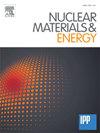EAST真空容器内诊断系统部件表面破坏的等离子体化学机理
IF 2.7
2区 物理与天体物理
Q1 NUCLEAR SCIENCE & TECHNOLOGY
引用次数: 0
摘要
该研究调查了 EAST 托卡马克上的光学诊断偏振计/干涉仪(POINT)系统中使用的多晶钼制成的后反射器表面退化的原因。根据对 X 射线光电子能谱 (XPS) 能谱的解释,对逆反射器表面进行了成分和深度剖面分析。深度剖面分析是利用能量为 2 keV 的氩离子溅射进行的,深度为 60 nm。在未清洁的逆反射器表面,观察到以下情况:主要存在三氧化钼 (MoO3),不存在未氧化的钼,存在来自结构细节的元素,包括 C 和 B、Zn、Fe、Cu、Ca、Na,含量不超过 1%。经证实,导致逆反射器表面降解,进而导致其反射性能下降的主要原因是,在技术间歇期和无等离子体放电的情况下,钼发生了活跃的化学氧化,随后在等离子体放电条件下,钼氧化物被等离子体化学去除。由于等离子体的加热和作用,逆反射器表面被水蒸气和氧气氧化,随后钼氧化物被清除,这一循环过程导致逆反射器表面形成发达的形貌,从而导致反射率下降。据指出,由过渡金属(如 W 和 Mo)组成的内真空容器材料也会发生类似的过程。本文章由计算机程序翻译,如有差异,请以英文原文为准。

The plasma-chemical mechanism of surface destruction of the diagnostic system components inside EAST vacuum vessel
The study investigates the causes of surface degradation of the retro reflectors, made of polycrystalline molybdenum, used in the optical diagnostic polarimeter/interferometer (POINT) system on the EAST tokamak. The component and depths profiling analysis of the retro reflectors surface was conducted based on the interpretation of X-ray photoelectron spectroscopy (XPS) energy spectra. The depths profiling analysis was performed using argon ion sputtering with an energy of 2 keV to a depth of 60 nm. On the uncleaned retro reflectors surface, the following was observed: the predominant presence of molybdenum trioxide (MoO3), no presence of unoxidized molybdenum, and the presence of elements from constructional details, including C and B, Zn, Fe, Cu, Ca, Na with quantities not exceeding 1 %. It was established that the main cause of surface degradation of the retro reflectors and, consequently, the degradation of their reflective properties, is the active chemical oxidation of molybdenum during technical breaks and in the absence of plasma discharges, followed by the plasma-chemical removing of molybdenum oxides under plasma discharge conditions. The cyclic process of surface oxidation by water vapor and oxygen and subsequent removing of molybdenum oxides due to the heating and the interaction of the retro reflectors surface with plasma, leads to the formation of a well-developed morphology on the retro reflectors surface and, thus, to the reflectivity degradation. It is noted that similar processes occur with inner vacuum vessel materials, which consist of transition metals, such as W and Mo.
求助全文
通过发布文献求助,成功后即可免费获取论文全文。
去求助
来源期刊

Nuclear Materials and Energy
Materials Science-Materials Science (miscellaneous)
CiteScore
3.70
自引率
15.40%
发文量
175
审稿时长
20 weeks
期刊介绍:
The open-access journal Nuclear Materials and Energy is devoted to the growing field of research for material application in the production of nuclear energy. Nuclear Materials and Energy publishes original research articles of up to 6 pages in length.
 求助内容:
求助内容: 应助结果提醒方式:
应助结果提醒方式:


